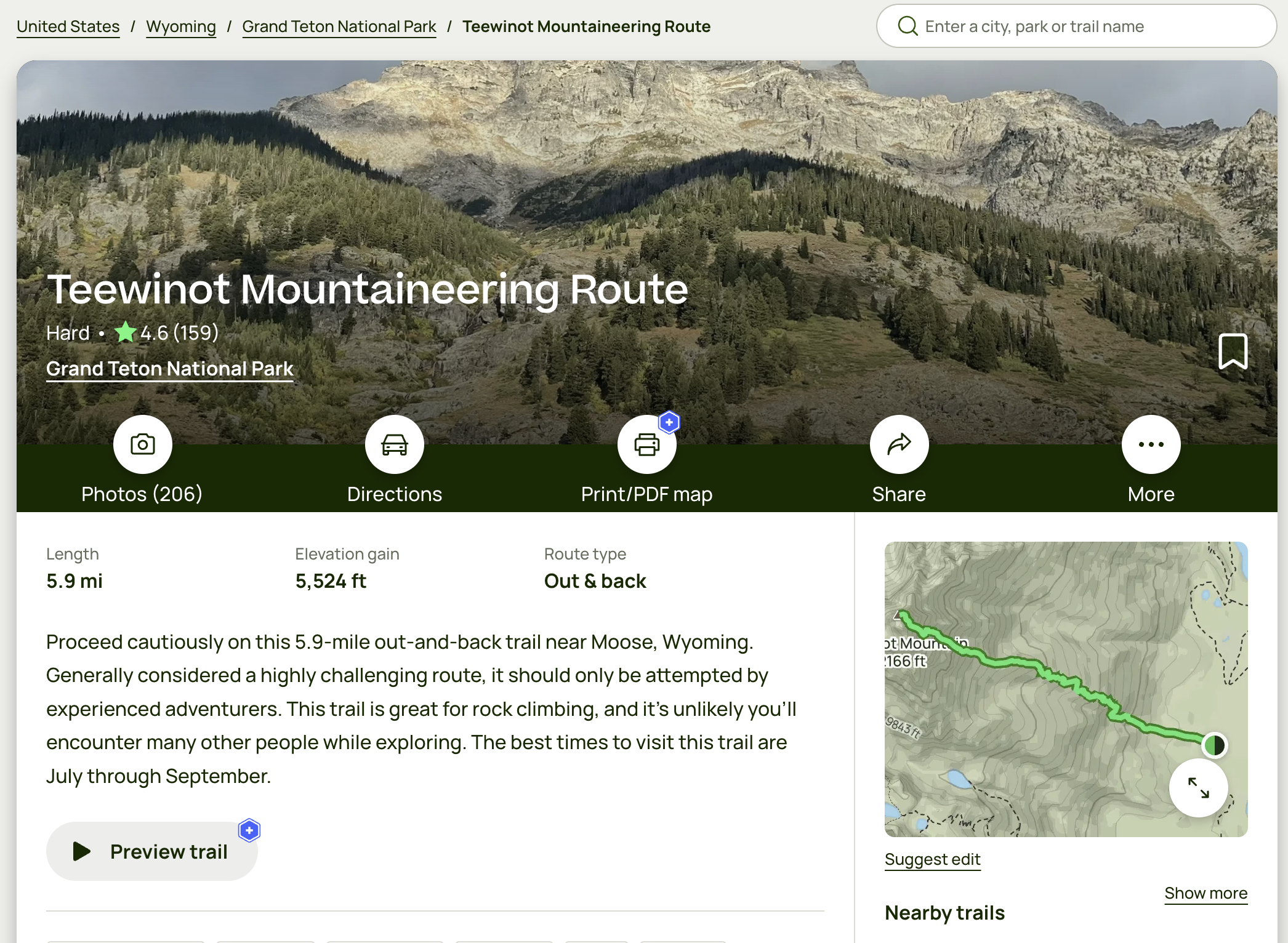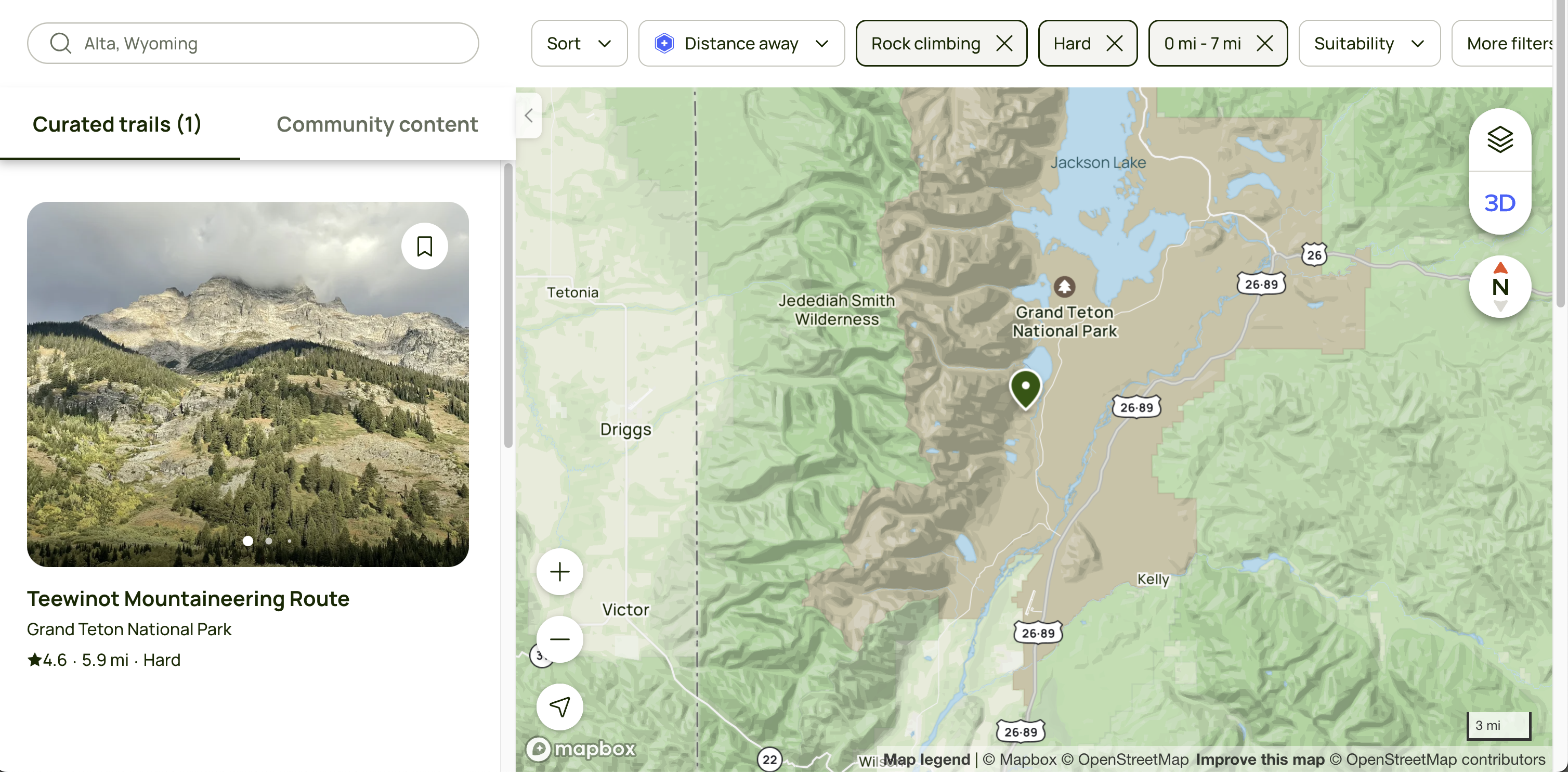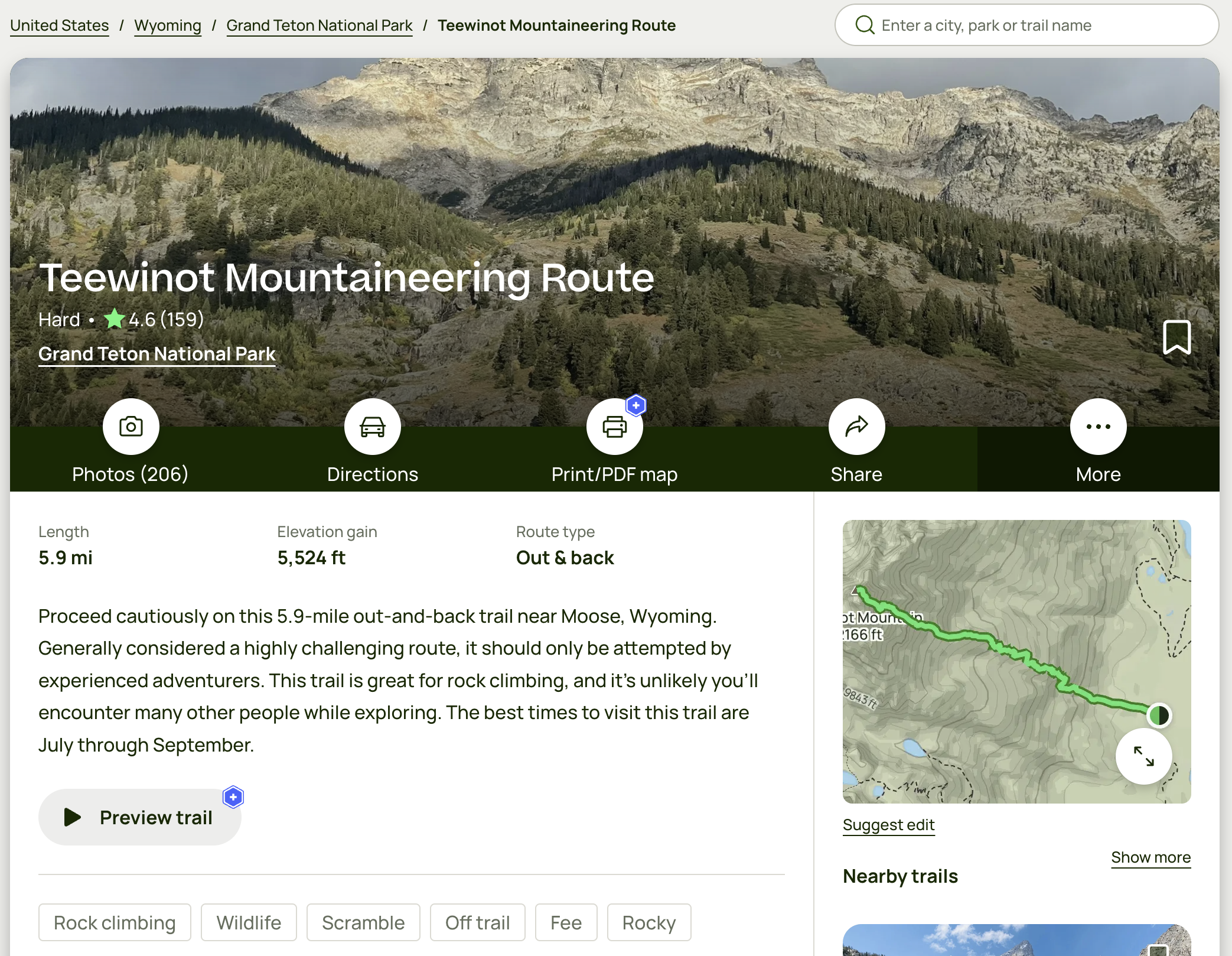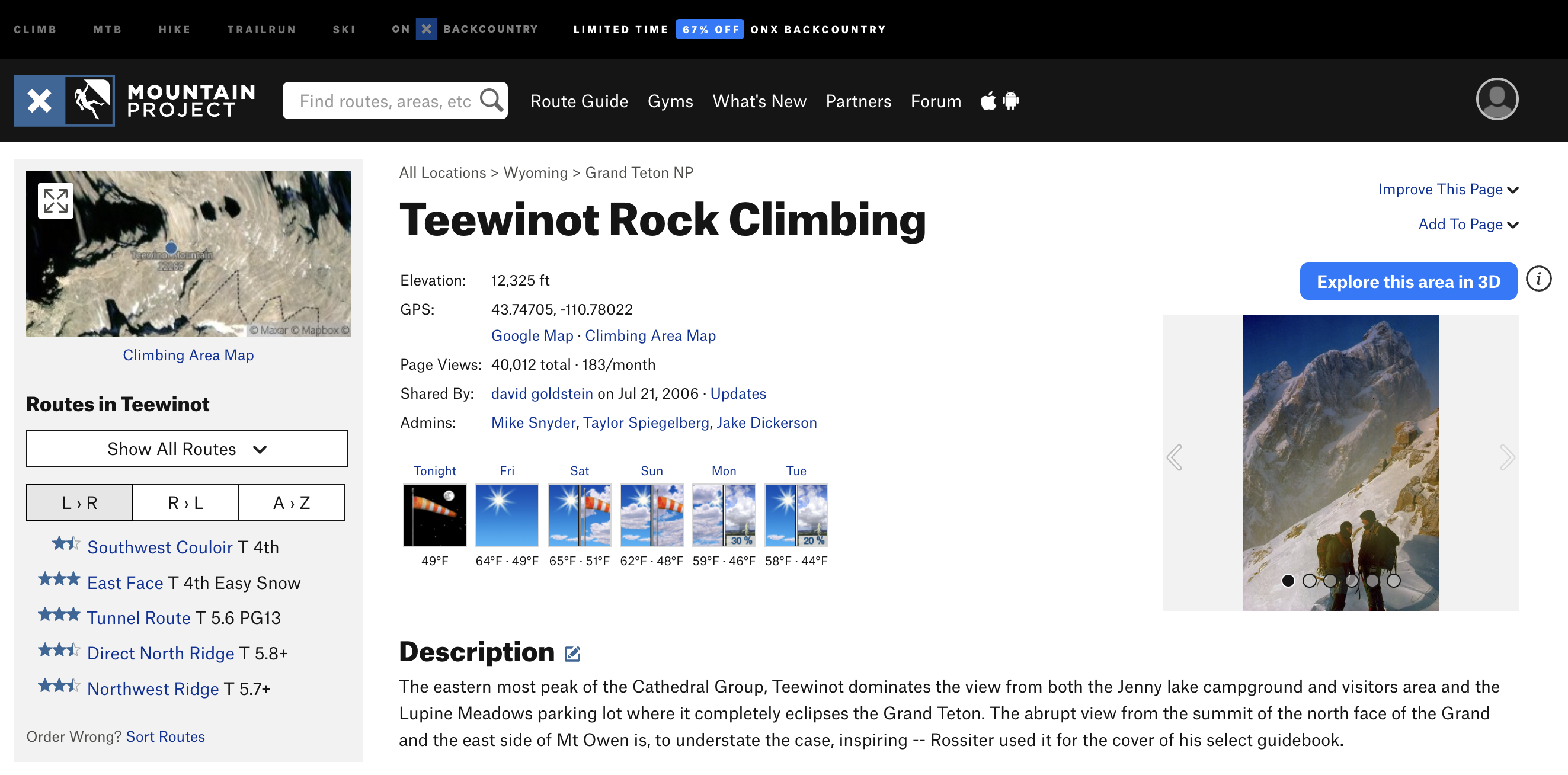AI and a duty of care
A recent post from the American Alpine Club has me considering the potential duty of care that websites like AllTrails and Mountain Project owe to their readers.
In The Prescription—July 2024, the editor Pete Takeda describes two incidents, one where two people were stranded due to their inexperience climbing snow, and another where one person in a group of nine slipped and fell to her death.
Recent accidents in Grand Teton National Park #
The American Alpine Club Prescription highlights a route on the Teewinot mountain in Grand Teton National Park that has claimed many lives. Introducing the accidents, Takeda points out:
While these accidents differ in immediate cause and final outcome, they share a common origin: the use of hiking-specific applications for selection, preparation, and route-finding, versus the use of climbing-specific resources.
In the conclusion and analysis, he goes further, pointing out the use of hiking-focused apps as a key root cause:
Use of Hiking Apps. This team relied on information taken from a popular hiking application (as previously discussed in this Prescription). This climb in particular is listed on several platforms as a hike. Interviews with survivors revealed they were under the impression that the East Face of Teewinot was a traditional hike. It is a fifth-class climb.
Based on this information, he researched the AllTrails description of the route:
On the app, the updated route description reads like a ChatGPT-derived synthesis of crowd-sourced user comments. What it lacks in human nuance, it compensates with a tinny stridency.
To me, that immediately makes me wonder — is it actually generated text?
Is it generated? #
When you open the AllTrails page for Teewinot, the route is described as a mountaineering route, but the description sounds largely innocuous:
Proceed cautiously on this 5.9-mile out-and-back trail near Moose, Wyoming. Generally considered a highly challenging route, it should only be attempted by experienced adventurers. This trail is great for rock climbing, and it’s unlikely you’ll encounter many other people while exploring. The best times to visit this trail are July through September.
As Takeda also highlights, referring to this route as a trail in the summary is extremely misleading, and the text is almost certainly AI generated. How can I be so confident?
A press release published by AllTrails on June 13, 2024, titled AllTrails Reveals Major Update advertises Redesigned Trail Pages:
Redesigned Trail Pages
AllTrails overhauled its more than 400,000 Trail Pages to help trailgoers plan with confidence, making essential information more accessible and visually engaging. Key details like trail length, format, and estimated duration are more prominent, and the pages now include the ability to visually tour the trail in a dynamic Photo Gallery, view the route in 3D, assess trail conditions, and read an AI-powered summary of community reviews.

However, there’s nothing on the page to indicate that the summary is AI-generated, nor any details about what prompt is being used to shape the community reviews into a summary of the route.
A local route near me that I discovered on AllTrails contains similar language:
Enjoy this 59.5-mile out-and-back trail near San Francisco, California. Generally considered a challenging route. This trail is great for road biking, and it’s unlikely you’ll encounter many other people while exploring.
As someone who spends a lot of time crafting consistent content, this type of structured description is unsurprising. What is surprising is the use of the word trail for routes that a person wouldn’t describe that way.
Using the term trail to refer to a mountaineering route or a cycling route indicates to me that this text is almost certainly machine-generated, and that the instructions include guidance to use that term.
Data cleanliness and prioritization #
The use of the word trail to describe these non-hiking adventure routes isn’t a matter of data cleanliness. The fact that these routes aren’t for hiking and are instead for climbing or cycling is known, but not clearly communicated.
It’s an issue with how the data is prioritized and communicated on the site.
If you filter for hiking trails in Grand Teton National Park, this route does not appear. However, if you filter by the activity “Rock Climbing” this route does show up. The data is there.

However, on a trail description page, there is no “activity” filter or label — only a loose set of barely noticeable tags or labels that describe the route:

If this were an issue of unclear or missing data, filtering by activity wouldn’t be possible at all. Instead, the data is there but isn’t clearly highlighted or communicated on the page.
Don’t try to be the tool for everything #
A platform can be immensely valuable in a specific niche. AllTrails is fantastic for offering granular route details, community-sourced conditions, and other relevant information for hiking trails.
But AllTrails was built for hiking trails, and the machine generation tooling used to create summaries was clearly also built for hiking trails—despite the site now including a variety of routes for other activities.
The expertise and audience that built AllTrails into what it is today for hiking doesn’t automatically translate to other activities like rock climbing and cycling, and as such, isn’t appropriate to offer support for rock climbers (and probably cyclists too) the way that dedicated sites can.
Mountain Project, the go-to source for most online climbing information, is part of a conglomerate that has expanded over time to include mountain biking, hiking, trail running, and skiing. And it’s telling that the sites are separate — because the audiences and the risks are distinct.

Expanding to a new customer base requires building intentional content, and in the outdoors, access to that content often requires local community experts. Other sites that serve climbers and mountaineers, like SummitPost, or the climbing app Kaya, offer support for community experts and are mindful stewards of information.
It might not seem like a big deal to generate summaries for the different routes listed in AllTrails. It might even seem like a net benefit for consistency and clarity, making the outdoors more accessible and available.
But if those summaries are crafted by a poorly-instructed machine, rather than a person that understands the context and the risk involved in providing such a summary, you end up with a mountaineering route called a trail, and a 60 miles cycling route called a trail.
A product with “AI-powered summaries” that are actively misleading is a product that is neglecting its duty of care to the outdoor enthusiasts it aims to support.